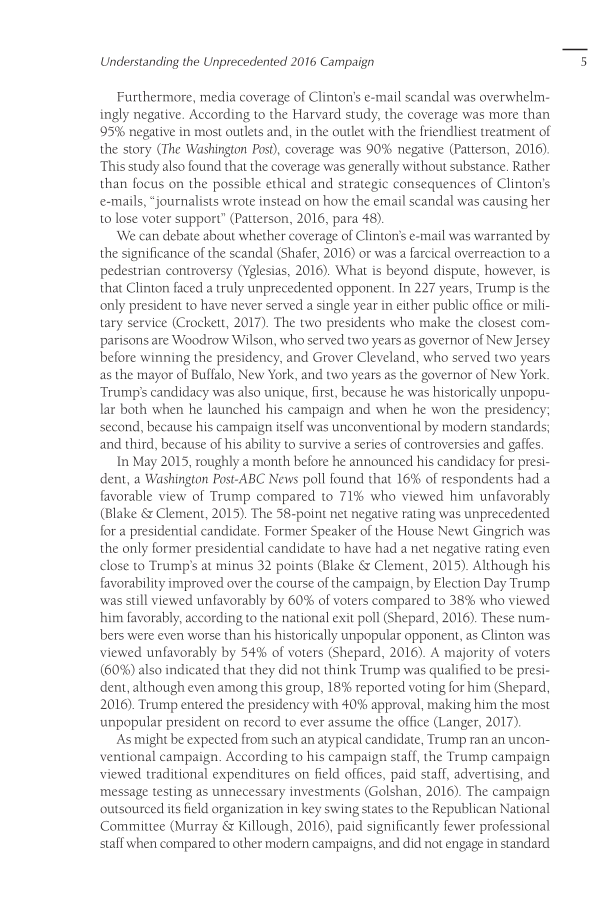Understanding the Unprecedented 2016 Campaign 5 Furthermore, media coverage of Clinton’s e-mail scandal was overwhelm- ingly negative. According to the Harvard study, the coverage was more than 95% negative in most outlets and, in the outlet with the friendliest treatment of the story (The Washington Post), coverage was 90% negative (Patterson, 2016). This study also found that the coverage was generally without substance. Rather than focus on the possible ethical and strategic consequences of Clinton’s e-mails, “journalists wrote instead on how the email scandal was causing her to lose voter support” (Patterson, 2016, para 48). We can debate about whether coverage of Clinton’s e-mail was warranted by the significance of the scandal (Shafer, 2016) or was a farcical overreaction to a pedestrian controversy (Yglesias, 2016). What is beyond dispute, however, is that Clinton faced a truly unpre ce dented opponent. In 227 years, Trump is the only president to have never served a single year in either public office or mili- tary service (Crockett, 2017). The two presidents who make the closest com- parisons are Woodrow Wilson, who served two years as governor of New Jersey before winning the presidency, and Grover Cleveland, who served two years as the mayor of Buffalo, New York, and two years as the governor of New York. Trump’s candidacy was also unique, first, because he was historically unpop u lar both when he launched his campaign and when he won the presidency second, because his campaign itself was unconventional by modern standards and third, because of his ability to survive a series of controversies and gaffes. In May 2015, roughly a month before he announced his candidacy for presi- dent, a Washington Post-ABC News poll found that 16% of respondents had a favorable view of Trump compared to 71% who viewed him unfavorably (Blake & Clement, 2015). The 58-point net negative rating was unpre ce dented for a presidential candidate. Former Speaker of the House Newt Gingrich was the only former presidential candidate to have had a net negative rating even close to Trump’s at minus 32 points (Blake & Clement, 2015). Although his favorability improved over the course of the campaign, by Election Day Trump was still viewed unfavorably by 60% of voters compared to 38% who viewed him favorably, according to the national exit poll (Shepard, 2016). These num- bers were even worse than his historically unpop u lar opponent, as Clinton was viewed unfavorably by 54% of voters (Shepard, 2016). A majority of voters (60%) also indicated that they did not think Trump was qualified to be presi- dent, although even among this group, 18% reported voting for him (Shepard, 2016). Trump entered the presidency with 40% approval, making him the most unpopular president on record to ever assume the office (Langer, 2017). As might be expected from such an aty pi cal candidate, Trump ran an uncon- ventional campaign. According to his campaign staff, the Trump campaign viewed traditional expenditures on field offices, paid staff, advertising, and message testing as unnecessary investments (Golshan, 2016). The campaign outsourced its field organization in key swing states to the Republican National Committee (Murray & Killough, 2016), paid significantly fewer professional staff when compared to other modern campaigns, and did not engage in standard
Document Details My Account Print multiple pages
Print
You have printed 0 times in the last 24 hours.
Your print count will reset on at .
You may print 0 more time(s) before then.
You may print a maximum of 0 pages at a time.









































































































































































































































































































































































































































































